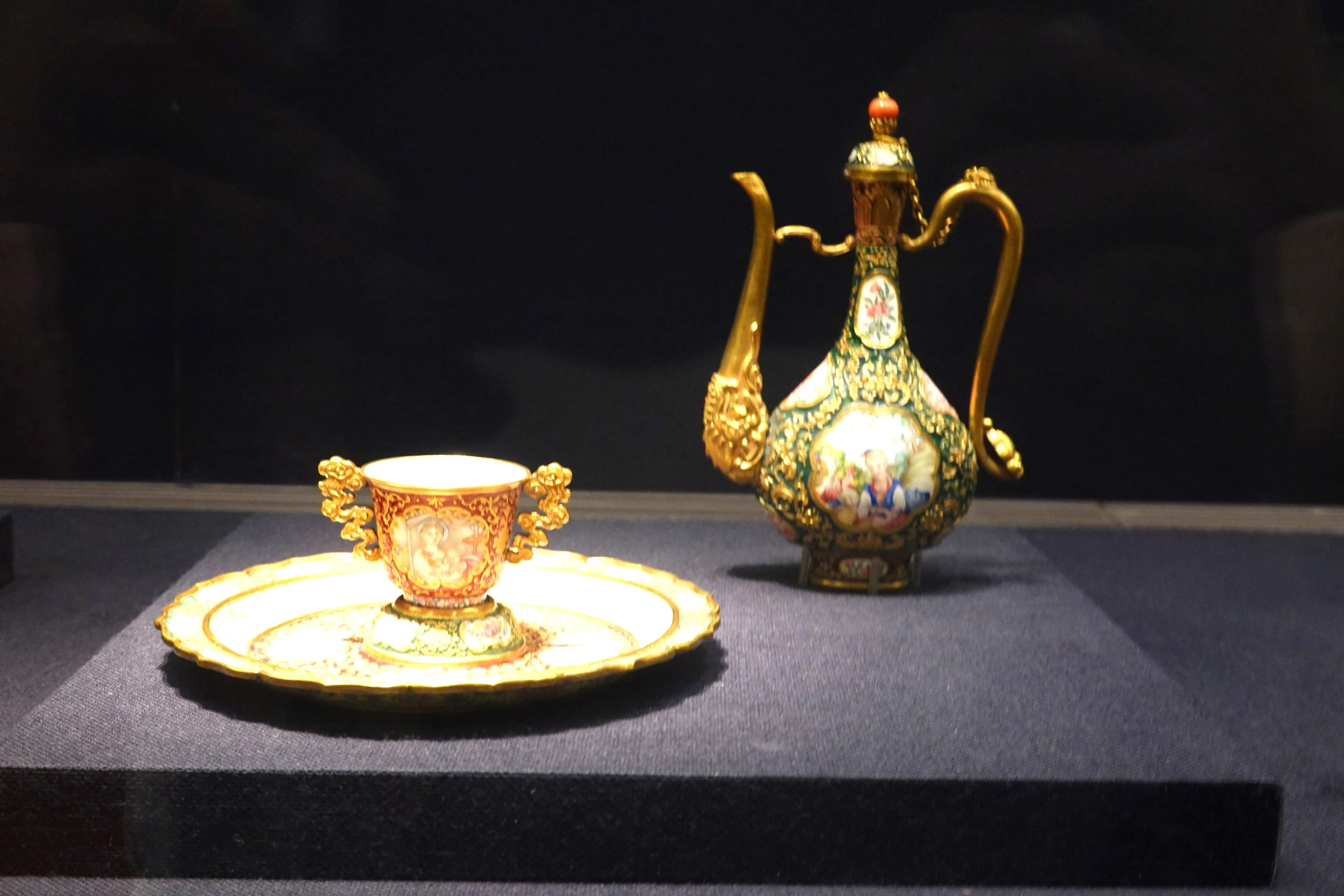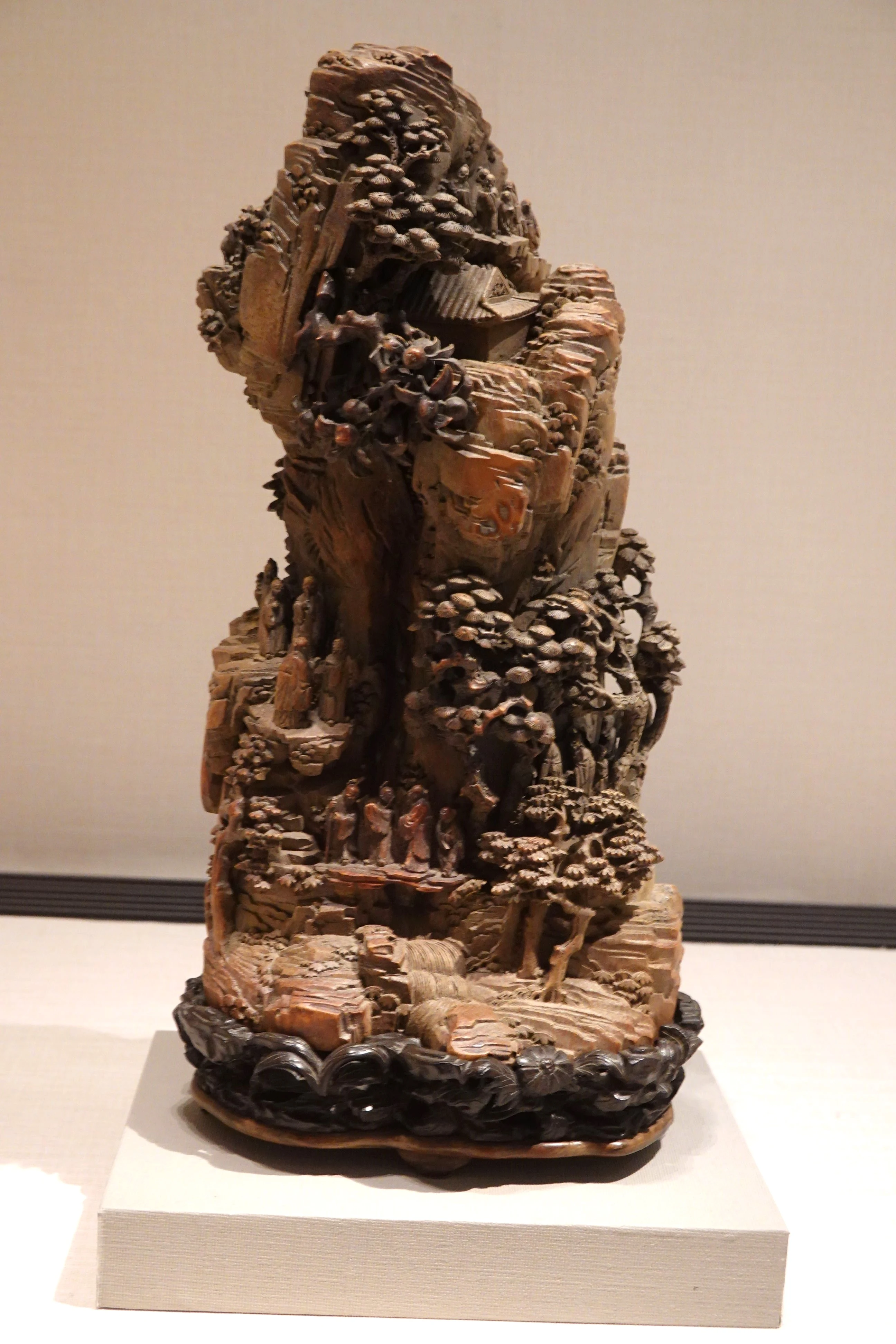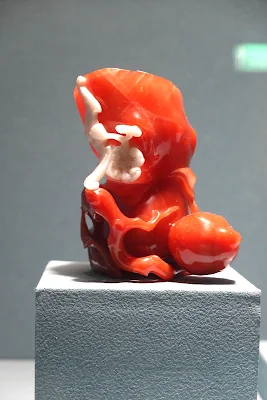The National Palace Museum, located in the Shilin District of Taipei City, with a southern branch in Taibao City, Chiayi County, is one of Taiwan’s most renowned cultural institutions. It houses world-famous Chinese art treasures inherited from the Song, Yuan, Ming, and Qing dynasties. The collection is broadly categorized into bronzes, calligraphy and paintings, ceramics, books and classics, handicrafts, and other palace cultural relics.
Unfortunately, we didn’t manage our time well and arrived a little late. As a result, we could only take a quick walk through the exhibits and were unable to fully appreciate each of the extraordinary ancient artifacts.
國立故宮博物院,簡稱臺灣故宮,別名中山博物院,主館於臺北市士林區,南部院區於嘉義縣太保市,藏有舉世聞名的中華藝術寶藏,收藏品源自宋、元、明、清四朝宮廷收藏,大致可分為青銅器、書畫、陶瓷器、圖書典籍、工藝品和宮廷類文物等等。
可惜我們時間沒算好,晚到了些,只能走馬看花快走流覽,沒能仔細欣賞一件件讓人讚嘆的古文物。




Up the River During Qingming 清明上河圖
The photos below depict the Qing court version of "Up the River During Qingming," a masterpiece of realistic genre painting. This version, a collaborative work by five Qing court artists, was completed in 1736, the first year of the Qianlong Emperor’s reign. It serves as an invaluable resource for studying the society and customs of the late Ming and Qing periods.
Additionally, the Palace Museum in Beijing holds a handscroll version of "Up the River During Qingming" by the Song Dynasty painter Zhang Zeduan. This original work captures the festive atmosphere and daily life of the people in Bianjing, the capital of the Northern Song Dynasty, during the Qingming Festival.
下面的照片是清院本「清明上河圖」,這是一幅寫實風俗畫的傑作,由清宮畫院的五位畫家在1736年(乾隆元年)合作畫成,是研究明清之際社會風俗的好材料。
另外在北京故宮博物院收藏了宋代畫家張擇端的一幅手卷「清明上河圖」,它展示了北宋時期首都汴京的人民慶祝清明節的節日氛圍和景觀。


Taoism and Religious Taoism 道家與道教
Taoism is broadly recognized as both a philosophy and a religion. The two are distinct yet interconnected. Philosophical Taoism is rooted in the teachings of Laozi, Zhuangzi, and the influential Huang-Lao school during the Warring States, Qin, and Han dynasties. It centers on the concept of “Tao” (the Way) and promotes principles such as purity, emptiness, and inaction in self-development and governance. It also offers guidance on relationships with others and attitudes toward the cosmos, based on the principle that “the Tao follows its own nature.”
Religious Taoism, however, seeks spiritual immortality and enlightenment through the Tao. Despite these differences, philosophical Taoism forms the foundation of Taoist religious belief, meaning the two must be considered interconnected rather than completely separate. From the Sui and Tang to the Ming dynasties, Taoism thrived, supported by the reverence of royal and noble families and gaining substantial social influence. However, as imperial preferences shifted toward Buddhism during the Qing dynasty, Taoism’s growth waned, and it fell from the heights of its former glory.
道家與道教是兩個相繫卻又相異的概念。道家以老莊思想為代表,用清虛無為的法則處理修身乃至治國,以道法自然的概念面對人與內外天地間的關係。
道教則是一種宗教,透過道的教化或修煉而達到成仙得道的目的。但道家是道教信仰的義理淵源,因此無法妄加分割。從隋唐開始至明代,多位皇室貴族的尊崇,道教信仰興盛,至清代,由於皇室信仰以佛教為主,道教發展漸衰。




A Garland of Treasures 集瓊藻
"A Garland of Treasures" is the title given during the Qing dynasty by the Qianlong Emperor to a curio box in his collection. As the name suggests, it refers to a group of small but precious artifacts. These include enamels, clothing and accessories, studio objects, lacquerware, Buddhist ritual implements, carvings, and curio boxes. Covering a wide range of forms and materials, these artifacts are especially numerous and of high quality.
This exhibition is divided into two themes: “Precious” and “Crafts.” “Precious” refers to the treasured materials and exceptional workmanship, while “Crafts” highlights the consummate skill involved in the design and production of these classical forms. Most of these items were used in daily life at the imperial court. They could be ritual objects, diplomatic gifts, accessories for ceremonial purposes, or part of the dress and makeup for those living in the ladies’ quarters. Some crafts were displayed in palace halls, served as curios to be appreciated at leisure, or were found in the scholar’s studio. Others are rare collectibles stored in chests, all specially designed and marvelously produced.
「集瓊藻」是乾隆皇帝所藏一件多寶格的名稱,意指蒐羅眾多珍貴美好的物品。所藏珍玩類有琺瑯、服飾、文具、漆器、法器、雕刻、多寶格等項,種類紛繁,品質精良。
本展覽以「珍」與「玩」為展覽主軸,「珍」是指材質珍貴稀有、工藝技法高超罕見;「玩」則指造形構思巧妙、製作精到古雅。這些珍玩類藏品多數是宮廷生活用器,有用於祭祀儀式、作外交餽贈的、典禮佩帶的裝身器、閨閣內堂梳妝品、廳堂上的陳設、文房几案的用具、休閒把賞的巧玩,還有收納多寶玩器的箱匣等。

明 萬曆 (1573-1620)掐絲琺瑯雙龍盤




清 (1644-1911) 鍍金嵌松石珊瑚火鐮盒 附乾隆款雕漆盒





清 (1644-1911) 伽楠香木手串 附錫盒








Red Sandalwood Furniture 紫檀家具
A suit of red sandalwood furniture was given to Prince Gong Yixin (1833–1898) by Emperor Xianfeng of the Qing Dynasty (1831–1861) for his mansion. The intricate carvings and fine carpentry exemplify the typical craftsmanship of Qing palace furniture. The display of this furniture and other cultural artifacts provides insight into the daily life of royalty.
這一批清朝咸豐皇帝(1831-1861)賞賜恭親王奕訢(1833-1898),做為王府之用的紫檀家具,雕刻繁複細緻,做工精良,是清代宮廷家具之典型。透過家具與文物的陳列,了解清代王公貴族生活的日常樣態。




A Dream of Red Mansions 紅樓夢
"A Dream of Red Mansions" is a novel in which the author recounts the story of an aristocratic family during the Qing Dynasty, depicting their rise to wealth and prosperity followed by decline. The National Palace Museum uses "objects" to interpret the novel, inviting us to explore the bygone era through these artifacts and materials.
《紅樓夢》是一本小說,追憶著盛清時期的貴族世家,由富貴繁榮到家族敗落的故事。故宮以「物」來讀小說,帶領我們藉「物」看見那段消逝的年華。

清 乾隆 (1736-1795) 金鑲東珠貓睛石嬪妃朝冠頂, 依身份不同,層數、東珠、珍珠及寶石數量等,皆有相應規範。





Ceramics 陶瓷
Ceramics are a sign of civilization. From processing the clay and shaping the forms to applying glazes and firing the products in kilns, the raw materials undergo many transformations as soft clay becomes durable ceramic. The forms, glazes, and decorative patterns on ceramics are diverse and varied, reflecting the different cultural and social conditions under which they were created. The exhibition is divided into four sections: Neolithic Age to the Five Dynasties, Song to Yuan Dynasties, Ming Dynasty, and Qing Dynasty.
陶瓷,是文明的象徵。從採石製泥、拉坯成形、施釉敷彩,至入窯燒成,軟泥轉變成了堅硬的陶瓷,每件作品背後的文化因素,讓造形、釉色和裝飾紋樣呈現出豐富多元的面貌,也形塑出時代的風格。展覽分成四個展區:「新石器至五代」、「宋金元」、「明」和「清」。
「新石器至五代」6000 B.C.E–960 C.E- 呈現陶瓷器由原始到成熟的階段


「宋金元」960–1350 - 從生活美學的角度,來看各個窯口瓷器的裝飾與美感






「明」1368–1644 - 陳述景德鎮御器廠的成立






「清」1644–1911 - 康雍乾三朝皇帝親自指揮御窯廠,官樣影響發揮至極














Chinese painting 古畫
The history of Chinese painting can be compared to a symphony. The styles and traditions in figure, landscape, and bird-and-flower painting have formed thematic elements that continue to blend into a unified composition to this day. Painters throughout the ages have made up this "orchestra," composing and performing many movements and variations within the tradition.
The foundations of figure painting were gradually established from the Six Dynasties period (222–589) through the Tang dynasty (618–907). Landscape painting then began to take shape during the Five Dynasties period (907–960), with variations influenced by geographic distinctions. Under the refined taste of Song dynasty emperors (960–1279), painters at the court academy developed their art to an unprecedented level.
Scholars believed that painting as an art form had to go beyond mere representation—beyond the "appearance of forms"—to express the artist’s ideas and personal cultivation. This belief laid the foundation for the movement known as literati (scholar) painting. In the Yuan dynasty (1279–1368), literati painters sought to revive the antiquity of the Tang and Northern Song periods as a starting point for personal expression.
From the Ming dynasty (1368–1644) onward, painting became increasingly distinguished by regional schools, which formed important clusters in the history of Chinese art. During the Qing dynasty (1644–1911), while the emperors promoted the "Orthodox School" style, they also tolerated Western painting techniques introduced by European missionaries. Concepts such as volume and perspective became known to and adopted by some Chinese painters, leading to a fusion of styles.
古畫發展如一部精彩的交響樂章,藉著人物、花鳥、山水等畫科的典範風格,組成幾項重要主題,並在歷史脈絡中加以變奏。
人物畫的典範在六朝至唐代(222-907)間。山水畫典範的成形約五代(907-960)之時。宮廷畫院在宋代(960-1279)藝術帝王的倡導下,發展出空前盛況。
宋代文人也將藝術的表現概念擴展到「形似」以外的範疇,文人畫開始成為一種新的風格。元代(1279-1368)的文人以復古為標。
明代(1368-1644)以後,不同地區的風格特色,成為藝術發展脈絡中的重要環節。清代(1644-1911)帝王在推崇「正統派」作風之餘,也包容歐洲傳教士所帶來的西洋畫法,立體與透視成為對古老典範的新詮釋。






The art of seal carving 篆刻藝術
The art of seal carving has a long and profound history, dating back to ancient times before the Qin Dynasty. It continued to flourish through the Song, Yuan, Ming, and Qing dynasties, and even into the Republican era, with the development of various renowned schools and styles.
Within the limited space of a seal, artists have expressed a wide range of artistic forms. The history of seals and seal carving is a rich and impressive tradition, shaped by seals created for various functions and purposes—including pictorial seals, official seals, private seals, idiom seals, and collector’s seals.
篆刻藝術歷史悠久,源遠流長,上自先秦古璽,下啟宋、元、明、清及民國名家流派,方寸之間,氣象萬千。
一部璽印篆刻的歷史,可說是由肖形印、官印、私印,以及各種閒章、收藏印,匯為大觀。


Gathering of Treasures 國寶薈萃
Meat-shaped stone 肉形石 and Jade Trio of Ring Symbolizing the Heaven, Earth, Human 玉「天地人」三連環


Sacrifice and Warfare 祀與戎
Sacrifice and Warfare: From tools for production and hunting to weapons for killing and combat, and from fulfilling basic needs to determining the outcomes of wars, the sharpness of the blade has long been central to weaponry and a timeless pursuit of human craftsmanship.
Humans first used stone to make blades. Later, with the mastery of revolutionary alloy technology, they successfully smelted bronze, thereby redefining the blade. In ancient China, bronze weapons emerged around 1800 BCE. These weapons not only demonstrated their power on the battlefield but also became part of the aristocratic ritual system, serving as ceremonial objects that symbolized their owner's social status and power.
祀與戎: 從生產與狩獵的工具到殺伐兵器,從滿足溫飽到決定戰爭勝負,刃的鋒利與否是關鍵所在,也是人類製器的亙古追求。
最初人類利用石材製刃,隨後人類掌握飛躍性的合金技術,冶煉出青銅。在古代中國,青銅兵器約出現於公元前1800年,兵器不只在戰場上大展身手,也融入貴族禮制,成為象徵身份地位的禮器。




Jade 玉
As far back as over seven thousand years ago, our forebears, through the toils of life such as digging and logging, came to recognize jade as a stone of beauty and eternity. With a glistening sheen like springtime sunshine and believed to be rich in jinqi (vital force or energy), this exquisite material was shaped—according to the principles of yin and yang—into round bi discs and square cong tubes, adorned with deistic and ancestral imagery as well as "encoded" symbols.
It was hoped that a power of "affinity," born from "artifacts imitating nature," would allow for communication with the Supreme God, who bestowed life through mythical divine creatures and, in doing so, created humanity. From this early animistic belief emerged the unique Dragon-and-Phoenix culture of China.
Throughout nearly eight millennia of development, jade carvings first embodied a religious ethic—reverence for heaven and respect for ancestors. Later, following medieval China, artistic pursuits that emphasized verisimilitude in both form and spirit reached their peak, reflecting the scholarly tradition of seeking the intrinsic nature of things. These two ideals together reveal not only the essence of the national character but also the deepest and most profound meaning of ancient Chinese jade: an art in search of heaven and truth.
遠在七、八千年前,生活在中華大地上的先民,從掘土、伐木等生活歷練中,認識了「玉」是「美而不朽」的石頭;它散發春陽般的光澤,令先民相信美玉含有豐富的「精氣」,也就是「能量」。將美玉按照心目中陽、陰二氣運行的模式,琢磨出圓璧與方琮,甚至雕刻出神祇、祖先的模樣,刻畫上「密碼」式的符號,希望經由「制器尚象」發揮「同類感通」的法力,與天帝對話。
他們相信萬能的天帝將神秘的生命力經由神靈動物的傳遞,才降生了人類。從「萬物有靈」的思維中,發展出中國特有的「龍鳳文化」。
總之,近八千年的發展,玉雕具體地展現了華夏民族敬天法祖的宗教倫理,中世紀以後,形神兼備的寫實手法達於高峰,說明中國文化中重視格物致知的治學傳統。「敬天格物」詮釋了我們的民族特性,也說明了中華古玉最深層的內涵。




















Bronze 青銅鑄器
The Bronze Age of China began in the late Xia dynasty (c. early 17th century B.C.E.) and lasted for about 1,500 years, spanning several dynasties from the Shang to the Western Zhou and Eastern Zhou. During these early periods, only members of the ruling class were permitted to commission and use precious bronze vessels. Bronze was primarily cast into ritual objects—alongside weaponry—for use in ancestral sacrifices, seeking blessings for an enduring lineage.
中國青銅時代開始於夏代晚期(約西元前十七世紀初),歷經商、西周、至東周,前後一千五百年左右。珍貴的青銅鑄器只有貴族才能使用,除了部分用來鑄造兵器、樂器外,主要鑄成祭祀容器,以盛裝祭品、獻祭祖先,祈求家族生命之綿延不絕。






Inkstones 硯
Inkstones have accompanied people through the ages. In a time before computer keyboards and the invention of fountain pens, writing and painting relied on four essential tools: brush, ink, paper, and inkstone. Among these, inkstones have truly stood the test of time. For approximately 2,000 years, they have undergone continuous change, evolution, and refinement—much like the ebb and flow of fashion trends—exhibiting a wide variety of forms and styles across different eras.
硯一直是人們的好朋友。電腦鍵盤還沒普遍以前,自來水筆尚未出現的時代,寫字、畫畫都少不了筆、墨、紙和硯,而其中又以硯,最能傳之久遠。大約有二千年,硯從出現、不斷變化、定型到再變化,就像流行風潮,在不同時代展現出百態千姿。


Travel/Point of Interest Posts 旅遊景點帖子

Comments